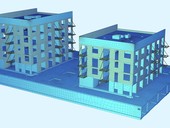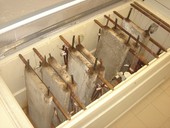Compartment fires are among the most frequent and also the most dangerous ones. Accordingly, we pay special attention to these fires in terms of fire tactics. In the Czech Republic, several facilities have been created to simulate fire conditions in enclosed spaces (“flashover containers”) and the firefighters have the opportunity to prepare for potential hazards. However, can this type of fires be special in terms of fire investigations?
Archiv článků od 14.12.2018 do 15.4.2019
Building Information Modeling (BIM) is being developed in almost all construction sectors in the Czech Republic. For Quantity Takeoff (part of Cost Management, referred to as BIM 5D), this brings many opportunities and challenges associated with the need of local workflows modification in accordance to information modeling needs. This article describes how data from BIM models can be used today to cost estimates using the proposed process scheme. It also indicates what needs to be done to achieve the full utilization of the BIM method in terms of cost estimation.
Fibre-reinforced concrete is increasingly used in structures where its properties can be utilized - especially tensile and residual strength after cracking. For applications in load-bearing fibre-reinforced concrete structures, it is necessary to ensure the uniformity of the steel fibres distribution in its structure. The paper summarizes the current knowledge of fibre-reinforced concrete production and test methods, which can be used to monitor the uniformity of fibres distribution in both fresh and hardened fibre-reinforced concrete.
The present research work at primary phase deals with the development of high strength heavyweight concrete based on cementitious composite comprising alternative raw materials and two types of high density aggregates (barite and magnetite). The design of concrete is based on six mortar specimens from which concrete blocks and prisms are prepared for physical and mechanical properties tests.
Mechanical Activation of Concrete: Determination of Efficiency for Differend Kinds of Waste Concrete
Waste concrete contains a portion of non-hydrated particles within a concrete paste. Because it is a valuable material, ways how to reactivate and apply them during production of new materials are searched. The mechanical reactiovation seems to be a potential technique to achieve that. This method is based on very fine milling of waste concrete, resulting inmicronized powder. In the course of such process, unhydrated grains are uncovered. Hereby, these can be involved in future hydratation processes. In order to find the efficiency of such reactivation, the combination of two methods was employed, describing the shape and phase composition of the resulting grains. Three different kinds of waste concrete were tested, differed in their age, use, and method of production. It was found that old concrete waste with Belitic binder is the most suitable of them for the mechanical activation.
BIM processes have brought to the design process improvement in co-ordination between different professions and, in the case of the statics profession, facilitating the creation of a load-bearing structure model. The duplicate work was removed, where the same structural elements had to be modeled by two offices, both architectural and static. In addition, these models are now interconnected and coordinated. In this article, we will present the entire process on a project of the load-bearing structure of a set of apartment buildings with a common underground floor. It is designed on the basis of current European standards using BIM processes for its design and drawing documentation.
Construction and renovation often brings thermal-technical challenges in certain details of certain structures. These details often place strict limitations on the thickness of thermal insulations. This is where the so-called superinsulations (i.e. materials with exceptionally low thermal conductivity) can find good use. The paper focuses on the use of these superinsulation materials in the remediation of thermal bridges in door and window jambs.
Current trends and methods of production of steel for the reinforcement, quality grades and their graphic representation. Welding problematics of steel for the reinforcement of concrete, specifics affecting the quality of welds of reinforcing steel. Process approach to welding of reinforcing steel, welding processes, types of welds, their advantages and disadvantages. Qualification of welders and welding coordinators for welding of reinforcing steel, qualification of welding procedures, production tests and acceptance crireria of the organization for welding of reinforcing steel.
Durability is described as the ability of a material to maintain its physical and mechanical properties over time. In reinforced concrete (RC) structures, concrete is the ideal material to protect the steel reinforcement. However, the RC structures are exposed to environmental loads, which cause the deterioration of materials as corrosion of reinforcement. The standard STN EN ISO 9224 describes the calculation of the whole corrosion loss. Despite these calculations, it is appropriate to perform the measurements on the real samples, which are time consuming. For this reason, it is useful to use accelerated corrosion test. The basis of our research was to compare the results of thickness of corrosion loss in accelerated corrosion test according the standard STN EN ISO 9227 with the calculation of corrosion loss according the standard STN EN ISO 9224.
An example of reliability verification of existing concrete member represent an extension of previous authors contribution “New European document for assessment of existing structures”. The illustrative example of the member is based on the new Technical specification [2]) and valid Eorocodes ČSN EN 1990 [7] and ČSN EN 1991-1-1 [9]. The contribution should provide background information supporting implementation of the new European document on assessment of existing structures to national standards.
The knowledge of internal heat gains from people performing certain activities is important for energy simulation calculations. The most commonly used data are present in Czech standard for heat load calculation, based on the values specified in ASHRAE. The standard greatly simplifies heat production from children. A calculation based on the heat balance presents a production of sensible and latent heat from people, depending on age, physical proportions, type of activity and thermal conditions in space. The results are compared with the data presented in the literature including the ratio between convection and radiation heat flow. The main goal of the analysis is to determine the heat flow from the children as an input for energy simulation calculations of school buildings.
The upcoming CEN Technical Specification (TS) on assessment of existing structures is related to the fundamental concepts and requirements of the current generation of EN Eurocodes. The final draft of the Technical specification was already submitted to the technical committee CEN TC250 in April 2018. The document concerns all types of buildings, bridges and construction works, including geotechnical structures, exposed to all kinds of actions. It contains requirements, general framework of assessment, data updating, structural analysis, different verification methods (partial factors, probabilistic methods, risk assessment), interventions, heritage building. The submitted contribution provides background information on the principles accepted in the final draft of TS and practical examples of applications of existing structures including panel buildings.
Paper deals with the definition of energy flexible building, its impact on the stability of the grid with the planned increasing share of energy from renewable sources and the possibility of using the heat storage capacity of building structures. Paper further analyzes the selected methodology for evaluation of the energy flexibible building and gives an example of thermally activated building structures.
The article deals with a design of very slender steel columns loaded in compression. The design resistance of common compression columns results from the buckling resistance, which is due to a high slenderness low. Modification of a common column into a stayed prestressed system leads to a multiple increase of its design resistance. The article describes prestressed steel stayed columns with one central crossarm. First the formulas for critical loads of “ideal stayed columns” are presented, second the formulas for maximal resistances of “imperfect stayed columns” are given. The reduction of the maximal resistances by a material partial safety factor results into a design resistances in accordance with Eurocode 1993-1-1. Finally a solved example is presented with a comparison of resistances received for the prestressed (stayed) column and non-prestressed (common) column with a very high slenderness.
Oak wood is characterized by good durability against biotic damages. However, its surface treatment by coatings is problematic, especially in the exterior expositions. In most cases, there is a rapid degradation and damage caused by weathering. Transparent variants of coating systems suffer from this phenomenon even more than pigmented ones. The article contains the results of practical experiments that lead to some general recommendations, which use leads to surface treatment of oak wood in exterior with longer durability and better colour stability.
The subject of this paper is an experimental and numerical analysis of the stability of the wall panels with one-side board sheating. The reinforcement of the panel is provided by means of glued timber composite I-shaped element consisting of a web made of a wood-based desk embedded into flanges of solid timber. The mechanism of the behaviour of these panels, mode of the failure and reliable procedure to determine the buckling load-bearing capacity not been fully explored so far. The main aim of this project is to create reliable numerical model using experiments and parametric study for optimized design. Outcome of the work is a design model and dimension tables for one-side board sheating wall panels of light timber structures with a rib in the form of an I-stud.
Fluid fuel combustion technology in coal-fired power plants is also very popular in the Czech Republic, resulting in a relatively high production of a specific by-product – fluidized fly ash, which differs from the classical high-temperature fly ash in mineralogical composition with a high sulphur content of anhydrite CaSO4. Fluidized ash is not yet used in the production of fired building materials, where it could be used as a cheap source of calcium oxide (for example, the production of porous ceramic tiles). However, the issue of sulphur dioxide leakage during the re-firing of fluidized fly ash in ceramic raw materials mixtures has to be solved. This paper deals with the analysis of the basic properties of domestic fluidized fly ash and provides a reflection on its possible use in building production.
The article describes a virtual furnace for fire resistance test of structures. The virtual furnace is a numerical model of a ceiling furnace created in FDS (Fire Dynamics Simulator) program, which is based on the Computational Fluid Dynamics (CFD) method. The numerical model is validated by the aid of several fire tests carried out in a horizontal furnace at the fire laboratory PAVUS, a.s. Results of the gas temperature within the furnace show good agreement with the experiments, even in the case of presence of a flammable test specimen. The use of numerical modeling based on fluid dynamics analysis has been therefore proven to be a suitable method for modeling fire resistance tests.
Dowel joints with wooden fasteners are an important part of many timber structures. They have been used especially in historical timber structures. This type of fasteners can be used for the construction of modern wooden structures or for the production of individual wooden structural elements, such as the Holz100 system of the Austrian company Thoma or for similar Brettstapel structural elements. Actual normative materials (principally Eurocode 5) do not provide sufficient safe design description for such structural joints. A complex model of failures in different directions to the grain of wood is missing. The article focuses on a pilot study on the evaluation of mechanical behaviour of dowel joints and presents the results of experiments of all-wood joints with dowels made of various wood species.
zpět na aktuální články



















